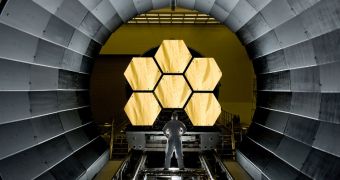Officials at the American space agency announce that the remaining 12 mirror segments for the James Webb Space Telescope (JWST) have finally been polished. This marks the completion of this leg of the construction efforts, which was deemed to be one of the most complex.
The completion of mirror polishing represents one of the most important milestones in the construction of this next-generation space observatory. The reason why the mirrors are so critical is that they form a critical portion of the science instruments that will go on the James Webb.
NASA selected its contractors carefully, for both building and polishing the mirrors. Engineers at the agency created draconian technical specifications, which called for the mirrors to be polished near perfection, with just a few atoms of leeway.
This level of quality is needed to ensure that the observatory is able to replace the Hubble Space Telescope, and see the earliest galaxies that formed in the Universe. These objects are located more than 13 billion light-years away.
“Webb's mirror polishing always was considered the most challenging and important technological milestone in the manufacture of the telescope, so this is a hugely significant accomplishment,” explains scientist Lee Feinberg.
He holds an appointment as the JWST Optical Telescope manager at the NASA Goddard Space Flight Center (GSFC), in Greenbelt, Maryland. The expert explains that there are four types of mirrors on the new flagship telescope.
Richmond, California-based L3 Integrated Optical Systems – Tinsley was responsible for polishing the mirrors, which are now perfectly flat within one millionth of an inch. The beryllium structures are also capable of operating at temperatures as low as minus 400 degrees Fahrenheit (-240°Celsius).
“The completion of the mirror polishing shows that the strategy of doing the hardest things first has really paid off. Some astronomers doubted we could make these mirrors,” adds John C. Mather.
The GSFC expert is the senior scientists on the JWST project, and also a laureate of the 2006 Nobel Prize in Physics. He and George F. Smoot received the prestigious award “for their discovery of the blackbody form and anisotropy of the cosmic microwave background radiation.”
“This milestone is the culmination of a decade-long process. We had to invent an entire new mirror technology to give Webb the ability to see back in time,” concludes Northrop Grumman Aerospace Systems vice-president and JWST program manager Scott Willoughby.

 14 DAY TRIAL //
14 DAY TRIAL //